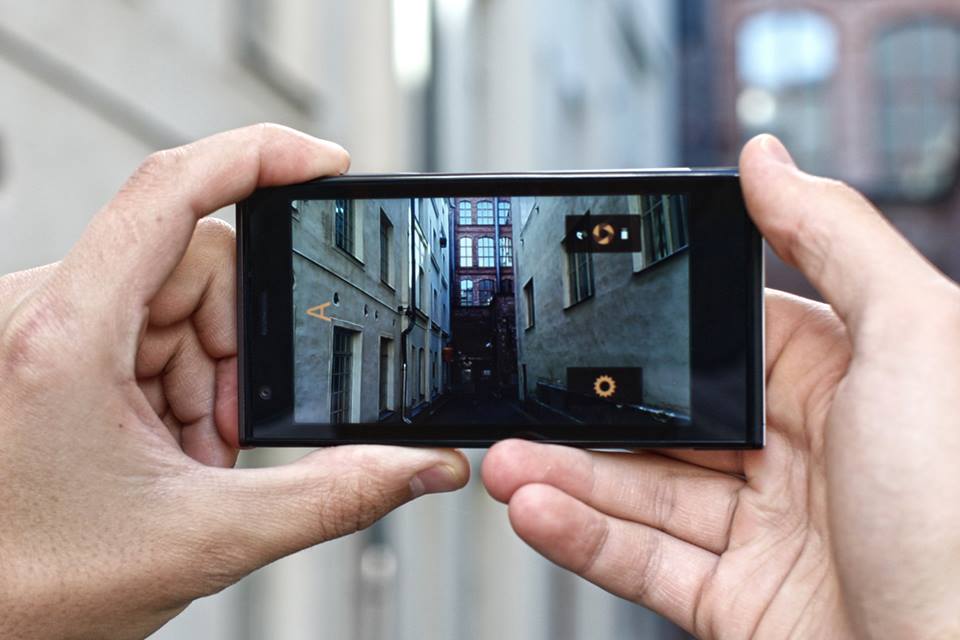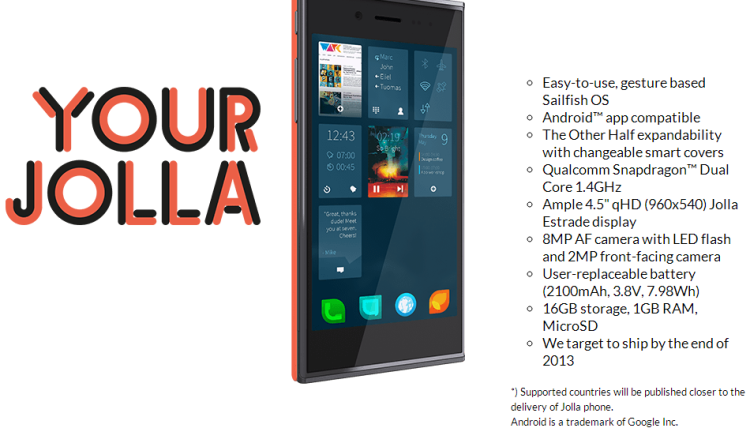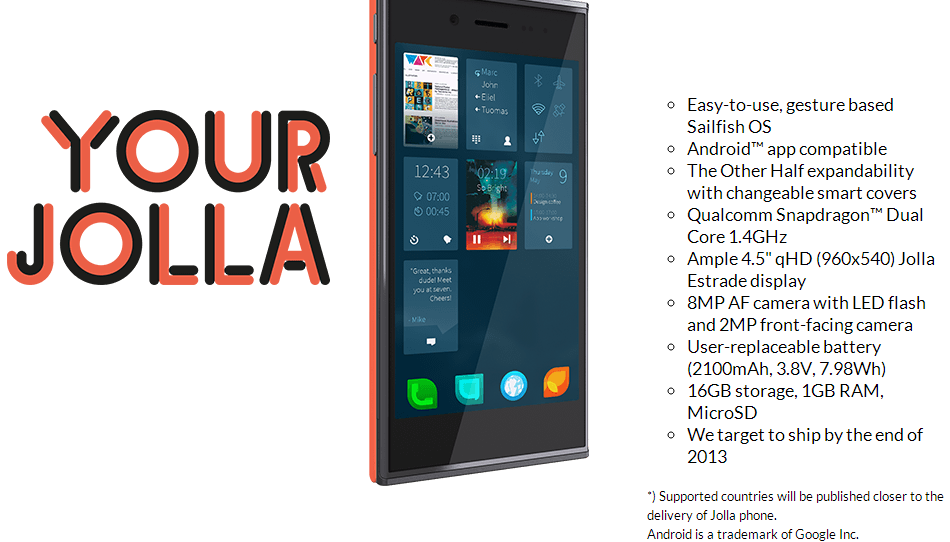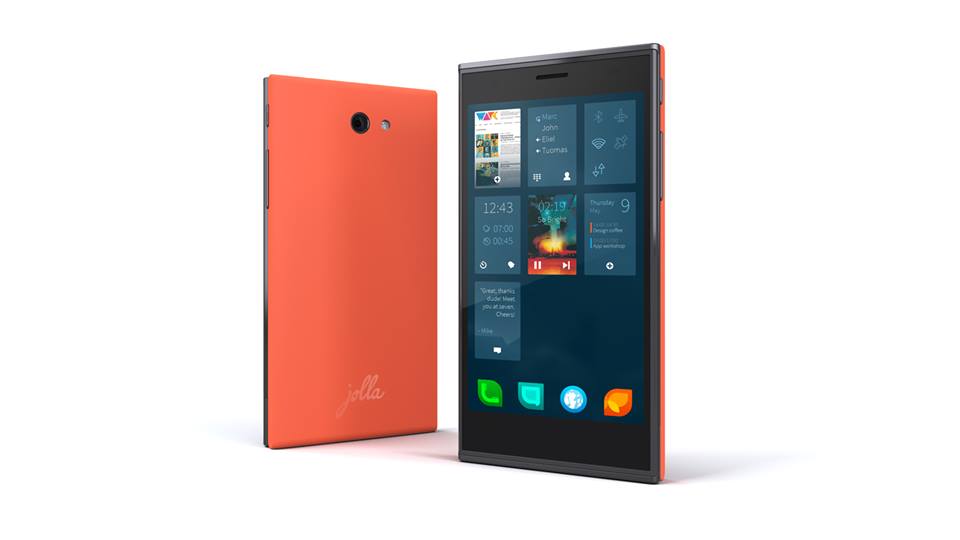Jolla has finally revealed detailed specifications on its first ever smartphone’s hardware. The smartphone, which will run on the company’s new Sailfish mobile operating system, looks to match its mid-range €399 price tag with equally mid-range hardware. The ace up Jolla’s sleeve, however, could be the game-changing Other Half smart covers – in addition to its recently-announced compatibility with Android apps.
Article continues after the jump.
First up, the Jolla (smartphone, not the company) will be powered by a Qualcomm Snapdragon dual-core processor with a clock speed of 1.4GHz. Jolla hasn’t revealed which Snapdragon variant it is, though it is most likely a Snapdragon 400 chipset as used in the HTC One Mini and Samsung Galaxy S4 Mini. There’s 1GB of RAM and 16GB of flash storage with support for microSD cards, while Jolla has also fitted a generous 2100mAh user-replaceable battery pack in the smartphone. One disappointment is in the 4.5-inch “Jolla Estrade” display: it’s only a 960 x 540 resolution screen, which many in the community found to be against the “HD” promise as revealed during the device’s global unveiling in May.
That aside, the focus is also clearly on what the company calls “The Other Half”. While the English product webpage states it as being nothing more than being “exchangeable smart covers”, the Finnish language product page offers a lot more tantalising details. The Other Half, as Jolla has hinted many times before, is more than just interchangeable NFC covers. The Other Half connects to the Jolla phone via NFC, has power input and output, and a unique I2C data bus sends and receives data between phone and Other Half.
I2C, short for “Inter-Integrated Circuit”, is used to attach low-speed peripherals to a motherboard. It has actually been around since the 80s, with the most recent standard being regulated in 2012 that allows for clock speeds of up to 5MHz. The general consumer may not have even heard of I2C before, but its applications are more common in PC hardware as well as Arduino-based projects.
 The company also gave a first look at the camera UI on Sailfish OS
The company also gave a first look at the camera UI on Sailfish OS
The implementation of I2C connectivity explains a lot on why the Finnish startups have been wildly secretive regarding the smartphone’s Other Half concept. The solution is an ingenious one, and offers an immense amount of customisation options for The Other Half. Think of it as similar to the Phonebloks concept smartphone, only that this is the real deal. With its capability of receiving (and delivering) power and transferring data, The Other Half can be, for example, a physical keyboard, a larger battery pack, a secondary flash module for the camera, a larger camera sensor…even a solar charger for the device. The ideas above have been thrown about within the community since The Other Half concept was revealed, and it does appear that the Jolla phone could very well support all of the above. All it takes, of course, is some active participation within the community – in line with the company’s core philosophy of “Doing It Together”.

Jolla’s Other Half concept in 39 seconds
The Other Half concept, together with Jolla’s Sailfish platform, has a very real chance to be the next disruptive device in the mobile industry – provided the company gets its marketing act right. It is puzzling to note why the company is mum on the full capabilities of the Other Half in its (presumably) more-visited English webpage, while revealing all in the Finnish product page. Why hide what can only be described as game-changing innovation? It isn’t the first time they’ve shot themselves in the foot, either.
All that remains, of course, is for Jolla – an 80-man startup founded mostly by ex-Nokia staff working on the ill-fated MeeGo project – to start shipping its Jolla smartphone out to consumers. The company recently announced a second wave of pre-orders for the Jolla phone exclusively for Finland (presumably to ride on a patriotic wave after Microsoft announced its agreement to purchase Nokia’s Devices and Services Division), while also maintaining delivery for the first batch by Christmas this year.

Now that the cat’s out of the bag, it is time Jolla starts leveraging on the positive wave of recent news to really promote itself. There is immense potential in many things Jolla is working on: the smartphone and the Other Half, the open-sourced Sailfish platform and its unique UI, the Qt framework and its cross-platform QML code.
It’s about time the world knows.




